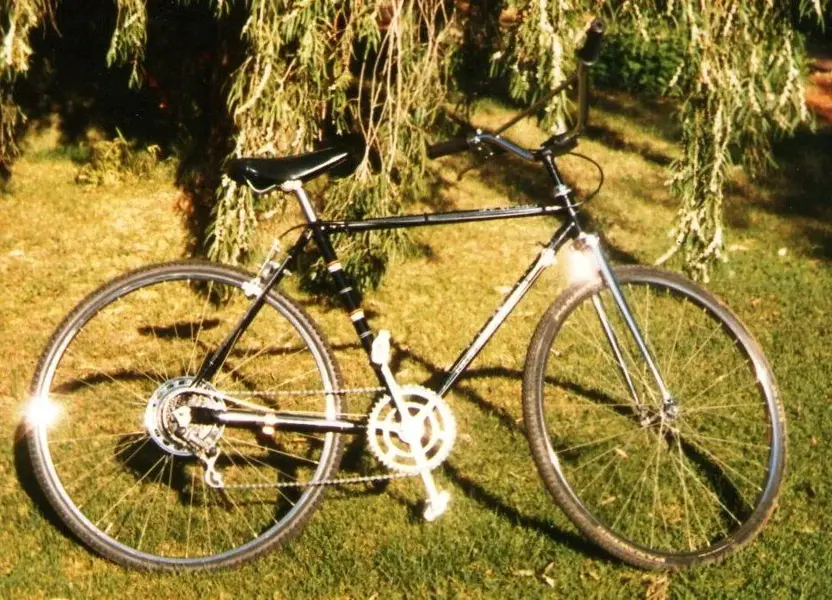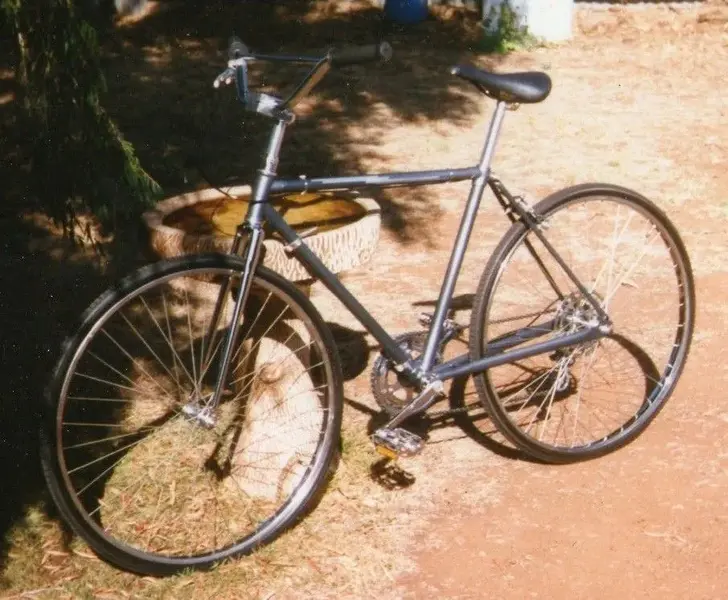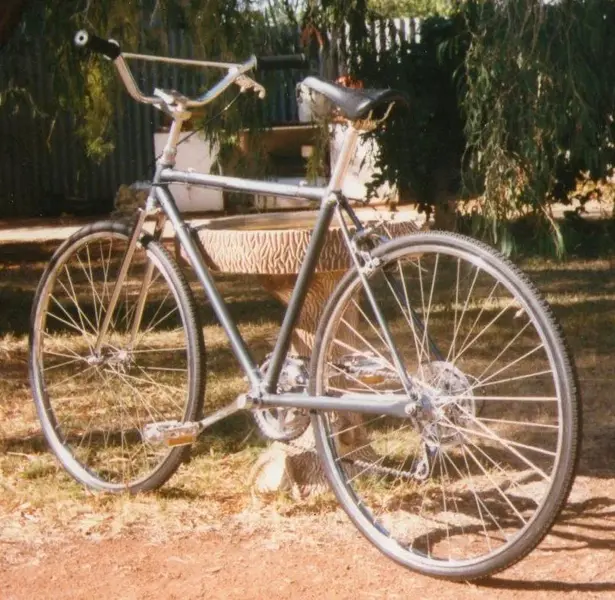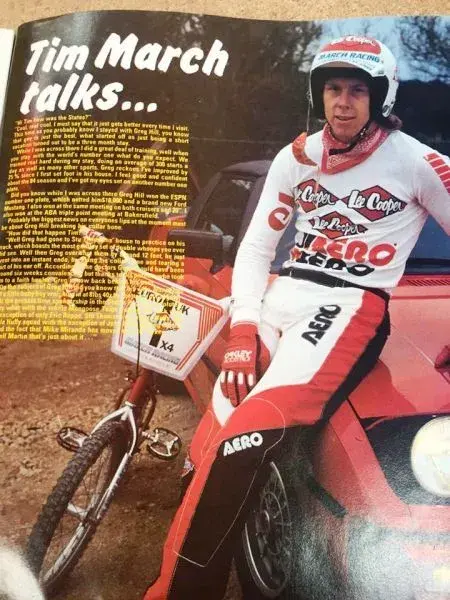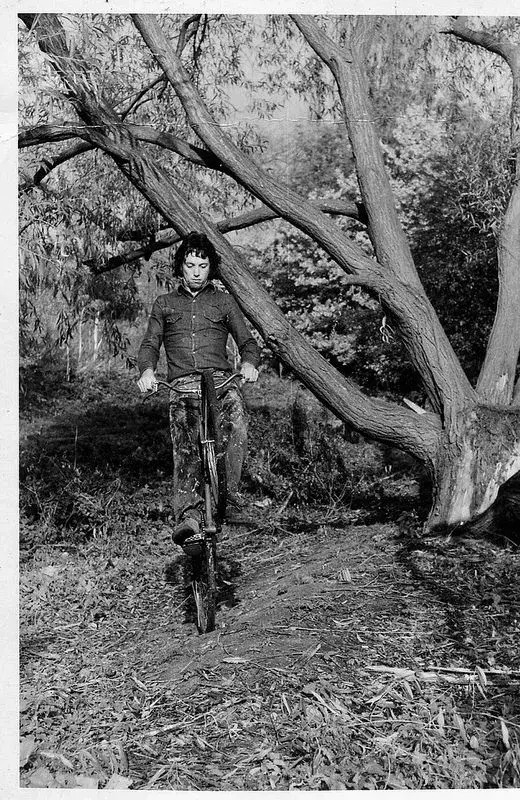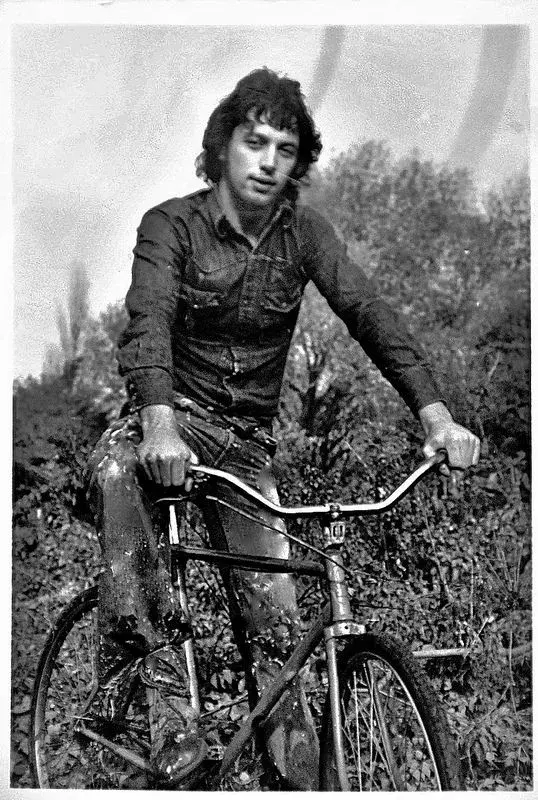Love seeing these old tracker cycles , some real beauties. We also rode them here in South Australia Here we called them Skid Kid bikes. They were patterned on cycle speedway bikes. Cycle speedway was very popular in this state and is still going here with 3 clubs, the most well known here being the Findon Skid Kids.Bikes that copied the look of cycle speedway were popular here with teenage lads. used old 26" roadsters, same cow horn bars and 26" x 1 3/8 tyres. Most had rear brakes only or no brakes, stopping by shoving your foot between rear tyre and seat tube. Here are photos of the one that I built in about 1982, using a South Australian made 26" Porshe (correct spelling) 5 speed racer which had drop bars It was a hand me down from brother. I put 27" straight forks on, BMX stem & MX bars. I rode it hard for yrs: 2 frames, 3 sets of forks, rear wheel, cranks & derailler. converted to cotterless cranks, used Trelleborg sweedway tyres when I could afford them.They wore out quickly. Local track was a creek with big jumps and used to bomb down steep dirt roads. I did big wheelies and lost heaps of skin. Hope you enjoy Pics
You are using an out of date browser. It may not display this or other websites correctly.
You should upgrade or use an alternative browser.
You should upgrade or use an alternative browser.
Trackers
- Thread starter willbloke
- Start date
cherrybomb
Old School Grand Master
- Feedback
- View
Re:
I never even knew they had a name! :shock:
We just used to call them 'our bikes' and built them because there were more places to ride off road than on the tarmac when i was eight or nine! (1977-7 .
.
That was just outside Worcester, and we pretty much all had them. The flash kids got Grifters but we just had 'our bikes'.
I had a child's Raleigh racer frame with single speed. fat (for then) tyres (not sure of what- there would have been adult assistance) and motorbike handle bars that my uncle, who was a proper oily biker, welded to the stem for me.
Well there you go- they were called trackers!
I never even knew they had a name! :shock:
We just used to call them 'our bikes' and built them because there were more places to ride off road than on the tarmac when i was eight or nine! (1977-7
That was just outside Worcester, and we pretty much all had them. The flash kids got Grifters but we just had 'our bikes'.
I had a child's Raleigh racer frame with single speed. fat (for then) tyres (not sure of what- there would have been adult assistance) and motorbike handle bars that my uncle, who was a proper oily biker, welded to the stem for me.
Well there you go- they were called trackers!
Hi all.
I came across this forum from trying to find a photo of a bike fitted with cowhorns and what a brilliant read it's been! For a while I'd been toying with the idea of building a bike similar to what I was riding as a teenager from around 75 to 79, ie a 5 speed racer with cowhorn handlebars. I have eventually had to buy a 10 speed peugeot due to a lack of decent 5 speeds to which will get added some scratch built bars made by a local pipe bending company. Anyway back to the 70s, I graduated to a proper bike from a blue MK1 chopper which I had for christmas in 1970. That bike was thrashed off road and wheelied to destruction, after having the frame welded several times it finally gave up the ghost and was I'm ashamed to say dumped on some waste land.
A relative worked for raleigh at the time and built from what I assume were 'spare' parts a 27" 5 speed racer. After a while the dropped bars were replaced with cowhorns,Mudguards removed and the plastic saddle changed for a much more comfortable brookes example. Someone mentioned earlier about the brake levers having to be mounted down by the second bend because the cables were too short, the other reason being that brake levers designed for dropped bars are the wrong shape to use on a straight length of handlebar. My mate and I hardly ever got off our bikes and were out in all weathers usually only wearing trainers, flares and Adidas tee shirts! Wheelies were perfected to the stage where you could get one up in second gear and go for pretty much as far as you liked as long as you were on a very slight uphill gradient as we were never good enough to take one hand off to select third. Another mod that hasn't been mentioned was shortening the pedals.This happened by accident initially when the pedals disintegrated by being grounded while pedalling through corners, the pedal eventually falling off to reveal the inner shaft, these were then hacksawn down to about two and a half inches which enabled you to keep pedalling with the bike leant right over without the fear of the back wheel being lifted off the ground and highsiding you. After a couple of painful gouges on the legs when your foot slipped off we soon learned to keep our feet on, didnt do much for the soles of your trainers mind! I can honestly say that in all that time I can't remember ever being out of breath or sweating, if only that was true these days!
I came across this forum from trying to find a photo of a bike fitted with cowhorns and what a brilliant read it's been! For a while I'd been toying with the idea of building a bike similar to what I was riding as a teenager from around 75 to 79, ie a 5 speed racer with cowhorn handlebars. I have eventually had to buy a 10 speed peugeot due to a lack of decent 5 speeds to which will get added some scratch built bars made by a local pipe bending company. Anyway back to the 70s, I graduated to a proper bike from a blue MK1 chopper which I had for christmas in 1970. That bike was thrashed off road and wheelied to destruction, after having the frame welded several times it finally gave up the ghost and was I'm ashamed to say dumped on some waste land.
A relative worked for raleigh at the time and built from what I assume were 'spare' parts a 27" 5 speed racer. After a while the dropped bars were replaced with cowhorns,Mudguards removed and the plastic saddle changed for a much more comfortable brookes example. Someone mentioned earlier about the brake levers having to be mounted down by the second bend because the cables were too short, the other reason being that brake levers designed for dropped bars are the wrong shape to use on a straight length of handlebar. My mate and I hardly ever got off our bikes and were out in all weathers usually only wearing trainers, flares and Adidas tee shirts! Wheelies were perfected to the stage where you could get one up in second gear and go for pretty much as far as you liked as long as you were on a very slight uphill gradient as we were never good enough to take one hand off to select third. Another mod that hasn't been mentioned was shortening the pedals.This happened by accident initially when the pedals disintegrated by being grounded while pedalling through corners, the pedal eventually falling off to reveal the inner shaft, these were then hacksawn down to about two and a half inches which enabled you to keep pedalling with the bike leant right over without the fear of the back wheel being lifted off the ground and highsiding you. After a couple of painful gouges on the legs when your foot slipped off we soon learned to keep our feet on, didnt do much for the soles of your trainers mind! I can honestly say that in all that time I can't remember ever being out of breath or sweating, if only that was true these days!
- Feedback
- View
Given the rarity of detailed first hand accounts of UK 'Tracker' riding I have transcribed the 'Tracker' related parts of this interview.firedfromthecircus":228c5gfe said:Nothing new here really but just thought I should add this to the discussion...
http://www.daleholmes.com/wp-content/up ... mmarch.mp3
Particularly interesting is the information about 'Tracker' bike schoolboy clubs and motorbike scrambling events where hundreds of 'Tracker' bike riders took part in jump, wheelie, tail skidding and racing events:
‘Tracker biking’ memories, from an Dale Holmes interview with Tim March, British ‘1st Generation’ pioneer BMX rider. Aged 53 years (recorded in 2016)
From 2mins 35seconds onward:
Mine and Alan’s (Alan Woods) path in BMX is really parallel too, because both of us raced schoolboy motocross, and that was in the seven(ties) - err, Alan raced a lot longer, I think he was doing it for a lot longer than I was. I think that I only did it for, I started when I was 14, I think that Allan had been doing it for longer than I had, but during that time, what galvanised a lot of people from that era was the film “On Any Sunday” which came to England, and when you were in a moto-cross club it was quite similar to being in a BMX race club, you’d have your annual trophy presentations at the end of the year, and I am sure that, I might have this wrong but, it was something like this, we either had a special viewing of it, or it was something we had at the end of the year and everybody saw it and as you know it’s all about motorbikes but the bit in there about the kids being on these Huffy Penguins and Schwinn Stingrays was, it touched a real nerve with a load of people in schoolboy scrambling because we all had ‘Tracker’ bikes, which is essentially kind of shorthand for a bike that had knobbly tyres that you probably found down the dump and you did wheelies and skids on it, and you certainly would not have known what a bunny hop would have been err, back then. You know and that was the start of, that really and cycle speedway was the start of what I think probably was the thing that led into BMX and mountain biking, and that’s where I come from.
(4mins 20)...
.... I had been pestering my old man for a motorbike for years, I mean years, pestering him! And he wouldn’t buy me one and eventually he got to this point where he said we’d go to this motorbike racing and have a look ‘round, and I’d been riding over to the motorbike shops for ages and so when I went to Ringwood the first people I went to speak to were Chris and Craig, I saw Jeremy there and that was connection that I had with Craig straight away because in our Ringwood schoolboy scrambling club (I am making a long story of a short answer here so I’m sorry about that but it’s quite an interesting story.) At our Ringwood schoolboy scrambling club they would have a two day meeting every year called Cut Mill, and at that meeting there would be a wheelie contest, and it was fantastic Dale. You could not believe it because everybody that had a motorbike would bring their ‘Tracker’. So you would have hundreds of kids on ‘Tracker’ bikes with big cow-horns.
(Dale: That was the nub of my question, cow-horns, Is that what they had, yeah?)
Yeah, I hated cow-horns because you couldn’t hold them properly in the stem because you only had like a one bolt stem. The old goose-neck stem, the one bolt thing, they were absolutely (I was going to swear then) they were rubbish, and so. But there were a few kind of blags around that and Jeremy Watson’s dad had a welder and he welded his handlebars to the stem. And so, If you can imagine seeing that technology, that advancement in technology when you didn’t have a welder, it was kind of heart breaking because your handlebars would move up and down, you know what I mean, they would literally move up six or eight inches. So I used to use, almost like a touring handlebar, you know almost like a flat bar, and they wouldn’t pull up. But Craig used to win the wheelie contest, I couldn’t beat him, close but I couldn’t beat him and he was younger than me, and it used to really, really, piss me off. (8:43)
(9: 25)... Me and Craig used to meet over at Canford Heath which is where all the motor-cross bikers would congregate and loads of us would go around on pushbikes watching all the older riders on motor-cross bikes.
(10:23)... The Gales, they were unbelievable cycle speedway riders, and so we used to go ‘Tracking’ with them over Canford Heath, and we also had, I don’t know if you used to do this, but we used to build ovals in the woods, and they wouldn’t be flat, some of them would be undulating some of them would have roots on or whatever It was.
(14:50)...
At that time (1979) I was good enough on a bike that I could wreck one in about ten minutes, just by doing a jump. Just by doing one jump you would fold the wheel, bend the cranks, the handlebars would be bent. ‘Cos you would want to go that far and that fast, that they just didn’t last. And good old Jeremy Whatley ‘cos his dad had the lawnmower business, one of the bikes that he made, he made this bike, this would have been in 1978 I recon. He came down ‘my house and he’d made a bike that had suspension. And he’d made it, he put Puch Maxi wheels in this bike. You know the old pedal Puch Maxi’s? He’d put pedal Puch Maxi wheels in this bike, and the forks, he’d made the forks fit in the frame, and he could jump that, I recon probably about sixty feet. The jump from the field where he used to go is still there and he welded the crank arms to the spindle of this bike, and you could imagine what it would be like, the suspension back then, you couldn’t pedal it really because every time you pedaled it the bloody thing went down, you know what I mean. It wasn’t like today’s suspension where you pedal and go forward, this was just rubbish and as soon as you pedal, it took all your effort when you went down. But if you just coasted down a hill and floated off a lip, you could go absolutely miles on this thing, you know, and he’d put motocross bars on it. So that was the only type of thing that were available. Bikes from the dump and all that, there were Choppers, but that was a joke bike and they would last about two minutes. (...16:20)
Attachments
gravelbasher
Retro Newbie
Re:Trackers.
Trackers, a lost chapter in the history of British cycling. Pity there were no eye phones or digital cameras about in those days.
When I was a young teenager in the sixties in northern England the only real bike was a tracker bike. All the boys in our neighbourhood had them. They were a universal transport vehicle, to school, shopping but most of all bombing about in the woods and on the local pit slag heaps. I remember them as a mixture of bits from all other types of bikes and no two trackers were ever the same.
As they were used, parts broke and were replaced with whatever was available so some of the bikes ended up having a unique look about them. As kids we did´nt have the know how or the tools to do effective repairs so it was often a challenge to keep the bikes running. Luckilly there was usually a father or a big brother who would take pity on us and help with repairs or weld a cracked frame.
As we became better at riding we also wanted better performance and handling so we began to think more about about improving the bikes. The main improvement was buying speedway style tyres but some kids began to look at the mechanics of the bikes. This resulted in shorter pedal arms giving a more agressive cornering, better gearing for hill climbing and acceleration and different sized wheels for more ground clearence much the same as the trials and scrambles motorbikes of the period. Typically a 28 inch front wheel and a 26 inch rear wheel. In those days it was often easier to find a 28 inch wheel and fork than a 26 inch in a scrapyard. Then it was just a question of finding someone to cut thread in the header tube so it would fit the frame.
Now, fifty years on I´m living in Denmark and working with kids with special needs. Most of the kids function very badly in school class rooms but have undiscovered practical abilities and skills so for some of them the classroom is the bike workshop. Here we have started a project building tracker bikes for the kids to use while they are in school. So far two have been built with three more on the way. The bikes are so simple to build and maintain that the kids can manage most of it themselves. As for riding the bikes, we drive to the local woods with the bikes in a trailer and just let the kid loose. It´s so rewarding to see them ride and see that they really are enjoying themselves and learning at the same time.
Trackers, a lost chapter in the history of British cycling. Pity there were no eye phones or digital cameras about in those days.
When I was a young teenager in the sixties in northern England the only real bike was a tracker bike. All the boys in our neighbourhood had them. They were a universal transport vehicle, to school, shopping but most of all bombing about in the woods and on the local pit slag heaps. I remember them as a mixture of bits from all other types of bikes and no two trackers were ever the same.
As they were used, parts broke and were replaced with whatever was available so some of the bikes ended up having a unique look about them. As kids we did´nt have the know how or the tools to do effective repairs so it was often a challenge to keep the bikes running. Luckilly there was usually a father or a big brother who would take pity on us and help with repairs or weld a cracked frame.
As we became better at riding we also wanted better performance and handling so we began to think more about about improving the bikes. The main improvement was buying speedway style tyres but some kids began to look at the mechanics of the bikes. This resulted in shorter pedal arms giving a more agressive cornering, better gearing for hill climbing and acceleration and different sized wheels for more ground clearence much the same as the trials and scrambles motorbikes of the period. Typically a 28 inch front wheel and a 26 inch rear wheel. In those days it was often easier to find a 28 inch wheel and fork than a 26 inch in a scrapyard. Then it was just a question of finding someone to cut thread in the header tube so it would fit the frame.
Now, fifty years on I´m living in Denmark and working with kids with special needs. Most of the kids function very badly in school class rooms but have undiscovered practical abilities and skills so for some of them the classroom is the bike workshop. Here we have started a project building tracker bikes for the kids to use while they are in school. So far two have been built with three more on the way. The bikes are so simple to build and maintain that the kids can manage most of it themselves. As for riding the bikes, we drive to the local woods with the bikes in a trailer and just let the kid loose. It´s so rewarding to see them ride and see that they really are enjoying themselves and learning at the same time.
- Feedback
- View
Duxuk
Retro Guru
I got my "scrambler" in 1976 for 70 pence. In '77 I built a suspension fork using the front suspension units from a Honda C50. The reversed blade fork fractured after a few months so I replaced it with a ridged fork with bars welded down the side for strength. I rode until '79 and it was the best sport there was. Still doing it but on an MTB since '92.
- Feedback
- View
Re:
I sent the following to a old cycling friend of mine who was riding what he describes as 'track bikes' before he moved onto mountain-bikes in the early 1980s:
"Each town city or village seems to have had a different name for these bikes with the most popular being ‘Tracker’ or ‘Dirt Track’ bike. The best explanation for this phenomenon is that the mainly teenage boys were emulating the motor bike scrambling their fathers and uncles were into or that they had simply seen on TV. I have also found examples of this phenomenon in France, Australia, New Zeeland and the USA. In the UK I have found stories of large ‘Tracker’ bike racing events being held alongside ‘Scrambler’ motorcycle meetings".
However, he disagreed about the TV link saying:
"I doubt it was tv that spread the word - it was still two channels of BBC type stuff but you are right that it was a wider phenomenon. I put it down to being driven of f the roads by the growing number of (tax subsidised) cars".
Or was it simply that it was fun to ride bicycles off-road even without being inspired by motorbike scrambling on TV or because the streets were becoming more and more crowded with cars. I remember that on the street where I grew up in the early 1960s, there used to be only one car regularly parked on the street and so it was quite safe for children to play and cycle. But later when there were lots of parked cars you couldn't always see approaching cars and as a result there were a few minor accidents. Luckily only the bikes got damaged.
What do contributors here remember were the reasons why they built and rode 'Tracker' bikes?
I sent the following to a old cycling friend of mine who was riding what he describes as 'track bikes' before he moved onto mountain-bikes in the early 1980s:
"Each town city or village seems to have had a different name for these bikes with the most popular being ‘Tracker’ or ‘Dirt Track’ bike. The best explanation for this phenomenon is that the mainly teenage boys were emulating the motor bike scrambling their fathers and uncles were into or that they had simply seen on TV. I have also found examples of this phenomenon in France, Australia, New Zeeland and the USA. In the UK I have found stories of large ‘Tracker’ bike racing events being held alongside ‘Scrambler’ motorcycle meetings".
However, he disagreed about the TV link saying:
"I doubt it was tv that spread the word - it was still two channels of BBC type stuff but you are right that it was a wider phenomenon. I put it down to being driven of f the roads by the growing number of (tax subsidised) cars".
Or was it simply that it was fun to ride bicycles off-road even without being inspired by motorbike scrambling on TV or because the streets were becoming more and more crowded with cars. I remember that on the street where I grew up in the early 1960s, there used to be only one car regularly parked on the street and so it was quite safe for children to play and cycle. But later when there were lots of parked cars you couldn't always see approaching cars and as a result there were a few minor accidents. Luckily only the bikes got damaged.
What do contributors here remember were the reasons why they built and rode 'Tracker' bikes?
Similar threads
- Replies
- 4
- Views
- 1K
- Replies
- 3
- Views
- 828
